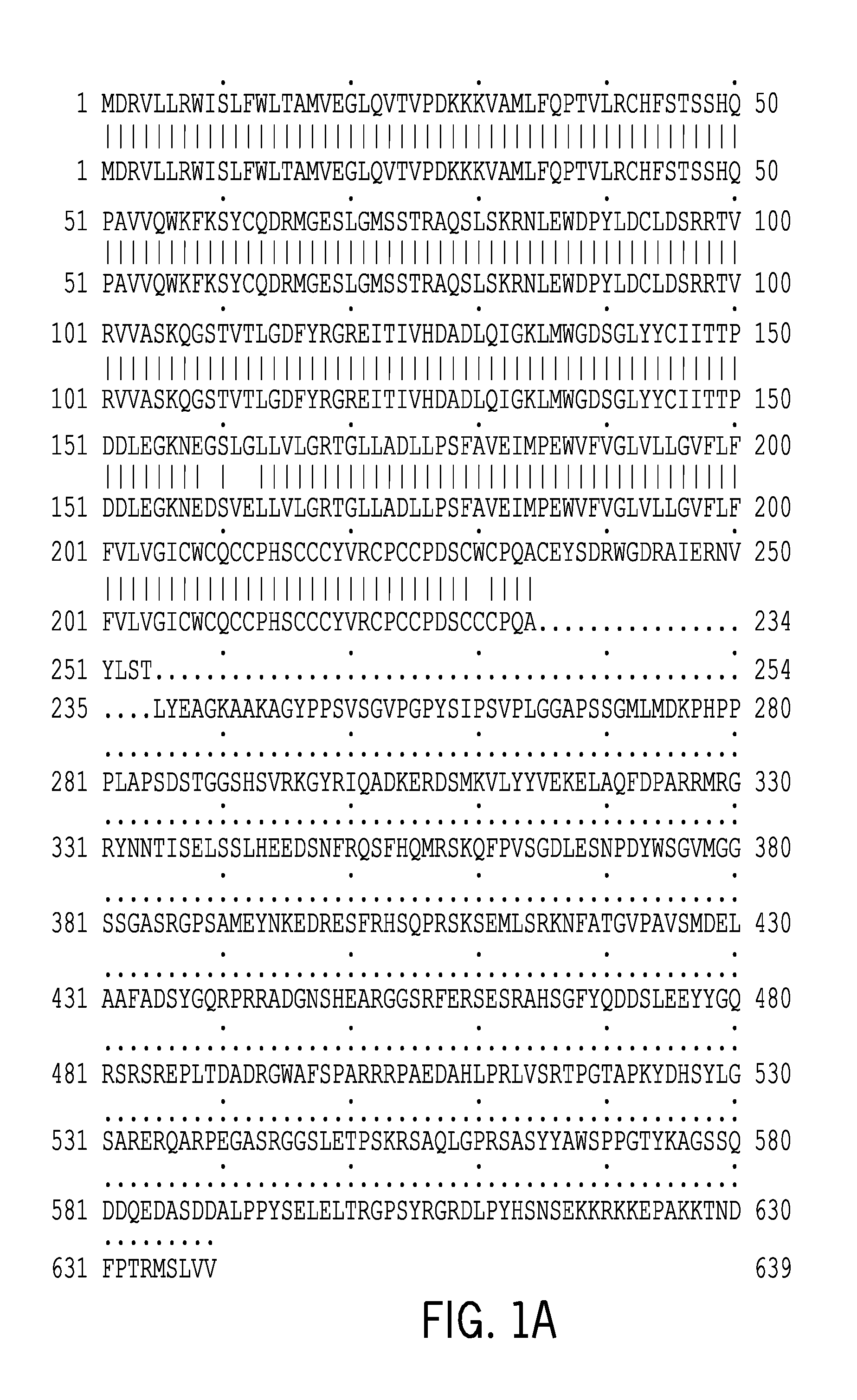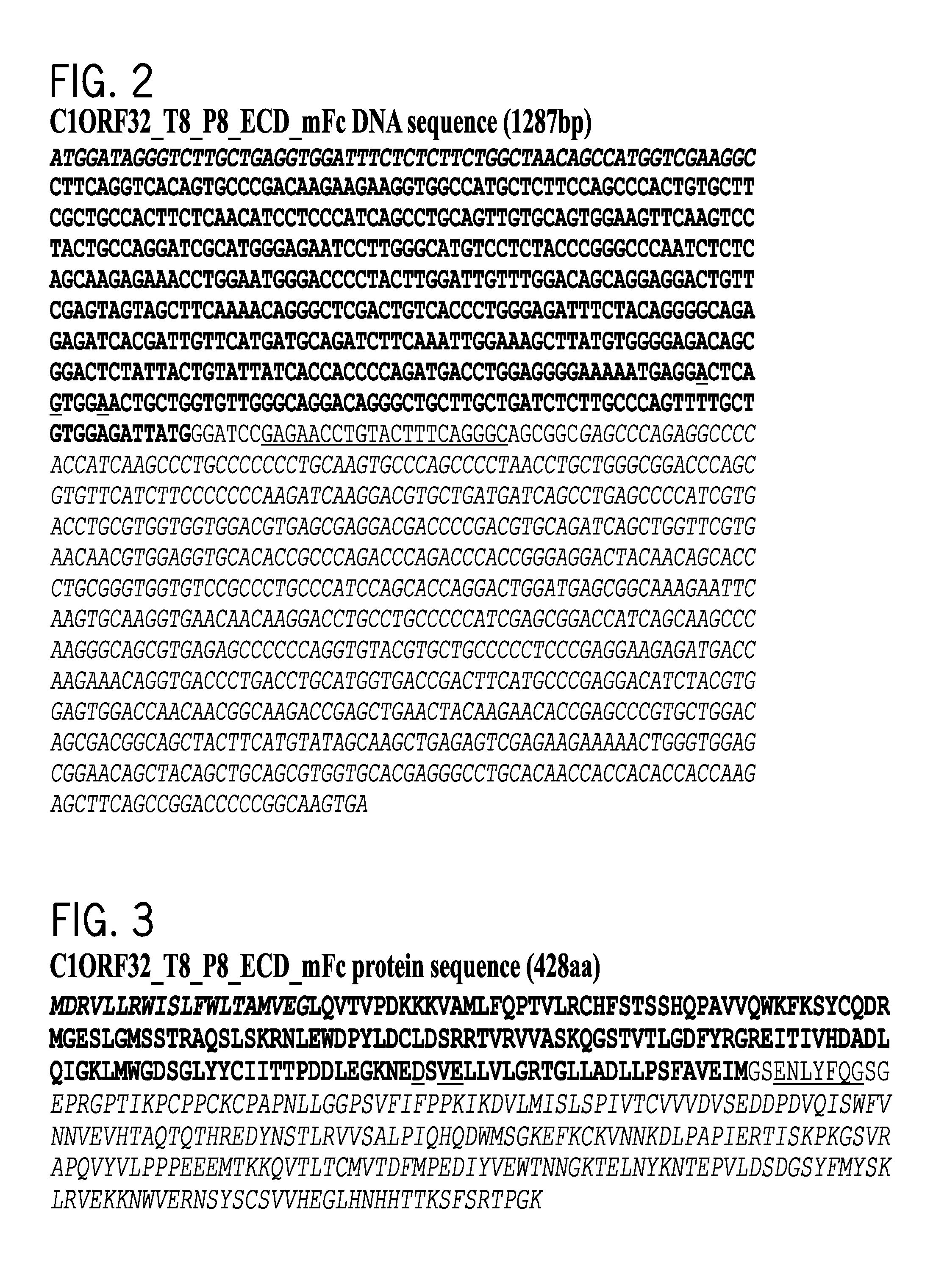Polypeptides and uses thereof as a drug for treatment of multiple sclerosis, rheumatoid arthritis and other autoimmune disorders
a technology of polypeptides and autoimmune disorders, applied in the field of polypeptides, immunotherapy, and drug development, can solve problems such as autoimmune diseases, and achieve the effects of preventing resistance to the second treatment, less frequent dosing, and reducing side effects
- Summary
- Abstract
- Description
- Claims
- Application Information
AI Technical Summary
Benefits of technology
Problems solved by technology
Method used
Image
Examples
example 1
Description for Cluster H19011—1 (H19011)
[0331]The present invention relates to C1ORF32 polypeptides, and diagnostics and therapeutics based thereon.
[0332]It should be noted that these variants were originally disclosed in PCT Application No. WO2009 / 032845, owned in common with the present application, which is hereby incorporated by reference as if fully set forth herein.
[0333]Cluster H19011—1 (internal ID 76432827) features 2 transcripts and 5 segments of interest, the names for which are given in Tables 1 and 2, respectively. The selected protein variants are given in table 3.
TABLE 1Transcripts of interestTranscript NameH19011_1_T8 (SEQ ID NO: 1)H19011_1_T9 (SEQ ID NO: 2)
TABLE 2Segments of interestSegment NameH19011_1_N13 (SEQ ID NO: 9)H19011_1_N8 (SEQ ID NO: 10)H19011_1_N10 (SEQ ID NO: 11)H19011_1_N11 (SEQ ID NO: 12)H19011_1_N12 (SEQ ID NO: 13)
TABLE 3Proteins of interestProtein NameCorresponding TranscriptsH19011_1_P8 (SEQ ID NO: 4)H19011_1_T8 (SEQ ID NO: 1)H19011_1_P9 (SEQ ID N...
example 2
Cloning and Expression of C1ORF32 Extra Cellular Domain (ECD) Fused to Mouse Fc
[0354]The purpose of this analysis was to clone the C1ORF32 ECDs fused via its corresponding C′ terminus to mouse Fc (mFc), and to express the fused ECDs in HEK293T cells (ATCC-CRL-11268), in order to be further used for functional assessment of C1ORF32 ECD.
[0355]The coordinates of the cloned ECD are described in table 8:
TABLE 8FullECDproteinTranscriptProteinlengthCoordinatesnameNo.No.(aa)(aa)SEQ IDC1ORF32T8 (SEQP8 (SEQ2541-184SEQ IDID NO: 1)ID NO: 4)No. 19
[0356]The cloning of the fusion proteins (ECD_mFc) was done in two steps:
[0357]1. Cloning of ECD to pIRESpuro3 (a bicistronic mammalian expression vector, Clontech catalog number: 631619).
[0358]2. Subcloning of the mouse Fc IgG2a comprising hinge, CH2 and CH3 regions of murine immunoglobulin Cγ2a chain in frame to the C′ terminus of the ECD previously cloned into pIRESpuro3, from step1.
[0359]Cloning of ECD to pIRESpuro3
[0360]Cloning of the ECD (correspo...
example 3
Protein Production of C1ORF32 Extra Cellular Domain (ECD) Fused to Mouse Fc (C1ORF32_P8-V1-ECD_mFc)
[0369]Production in HEK293T Cells:
[0370]To produce C1ORF32 ECD fused to mouse Fc (C1ORF32_P8-V1-ECD_mFc), pool of transfected HEK293T cells stably transfected with the corresponding constructs described herein above, were used. The transfected cells, usually maintained in 10% serum supplemented medium, were transferred into serum free medium (EX-CELL293, SAFC) supplemented with 4 mM glutamine and selection antibiotics (5 ug / ml puromycin), and grown in suspension in shake flasks at 37° C., with agitation. The culture volume was increased by sequential dilutions until a production phase of 3-4 days carried out in 2 L spinners flasks. Medium from the spinners was harvested, cleared from cells by centrifugation, filtered through a 0.22 μm filter and kept at −20° C.
[0371]The C1ORF32_P8_V1_ECD_mFc protein was purified using nProtein A—affinity chromatography as described below.
[0372]Harvests...
PUM
| Property | Measurement | Unit |
|---|---|---|
| Fraction | aaaaa | aaaaa |
| Therapeutic | aaaaa | aaaaa |
Abstract
Description
Claims
Application Information
 Login to View More
Login to View More - R&D
- Intellectual Property
- Life Sciences
- Materials
- Tech Scout
- Unparalleled Data Quality
- Higher Quality Content
- 60% Fewer Hallucinations
Browse by: Latest US Patents, China's latest patents, Technical Efficacy Thesaurus, Application Domain, Technology Topic, Popular Technical Reports.
© 2025 PatSnap. All rights reserved.Legal|Privacy policy|Modern Slavery Act Transparency Statement|Sitemap|About US| Contact US: help@patsnap.com



